Summary
In this post I will show how to create a function called VitaminData[ ] using information available in the Wolfram Knowledgebase. This custom function will provide chemical and physical data, molecule visualizations, lists of food sources rich on a specific vitamin and other nutritional data.
Function, data, uses:
By way of comparison, the vitamins in the list of entities:
EntityList@EntityClass["Chemical", "Vitamins"]

The function I created has an extended list of vitamins, of course some are questionable and/or old definitions, but I found it interesting to add to the function for didactic reasons and to make the study more complete.
VitaminData["List"]

Using the function more simply we get the vitamin in the form of entity:
VitaminData["A"]

With the optional Show we have several options, one of them is the 2D model:
VitaminData["B12", "Show" -> "Model2D"]
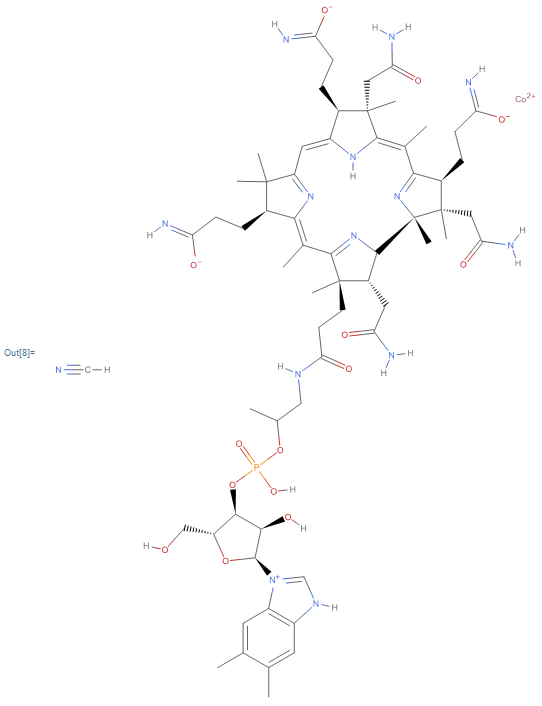
Using Show for the 3D model:
VitaminData["B12", "Show" -> "Model3D"]
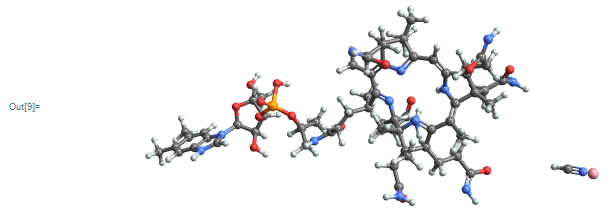
We can visualize each bond in the molecule with "Show" and "Bonds":
VitaminData["B5", "Show" -> "Bonds"]

We can count atoms and show their respective charges with "Show" and "Atoms":
VitaminData["B12", "Show" -> "Atoms"]

To have the complete list of properties available in the optional Show, use Properties:
VitaminData["A", "Show" -> "Properties"]
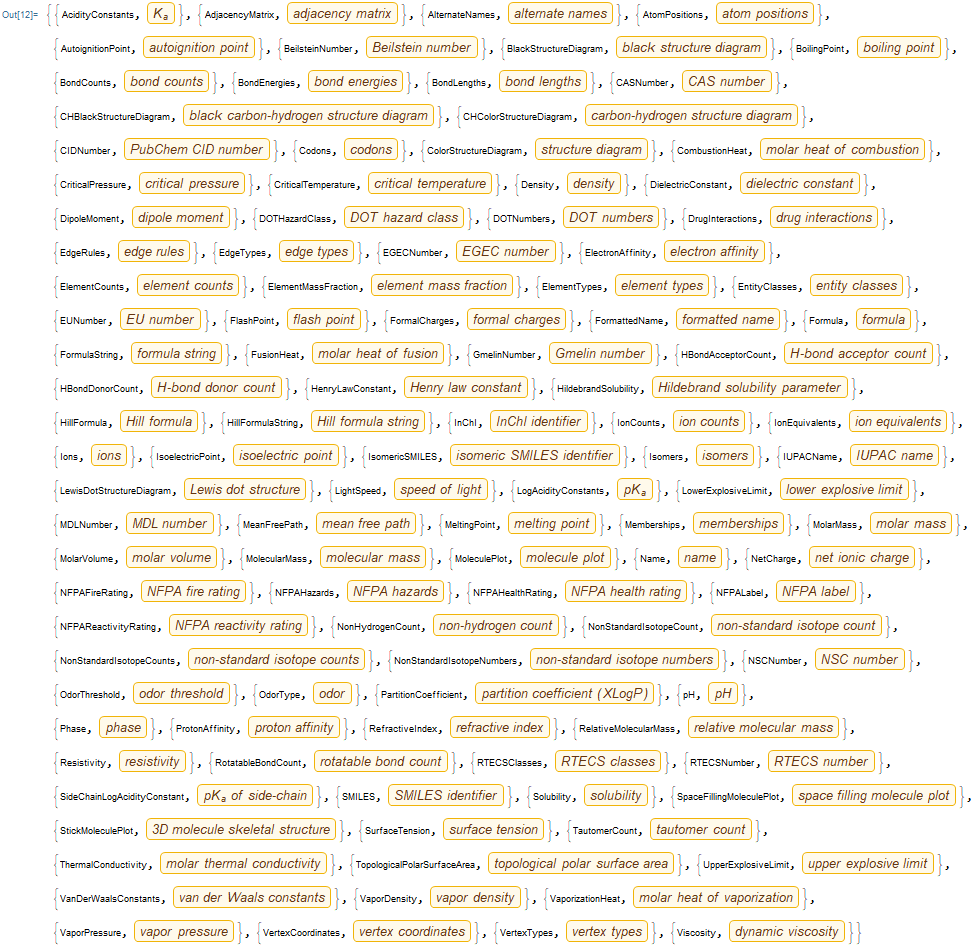
For example, the molecular mass:
VitaminData["H", "Show" -> "MolecularMass"]

Another example of one of the properties from the list above is NFPALabel:
VitaminData["K1", "Show" -> "NFPALabel"]
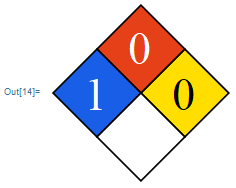
With the optional Show and Data, all properties of the above list are shown at once, interactively:
VitaminData["C", "Show" -> "Data"]
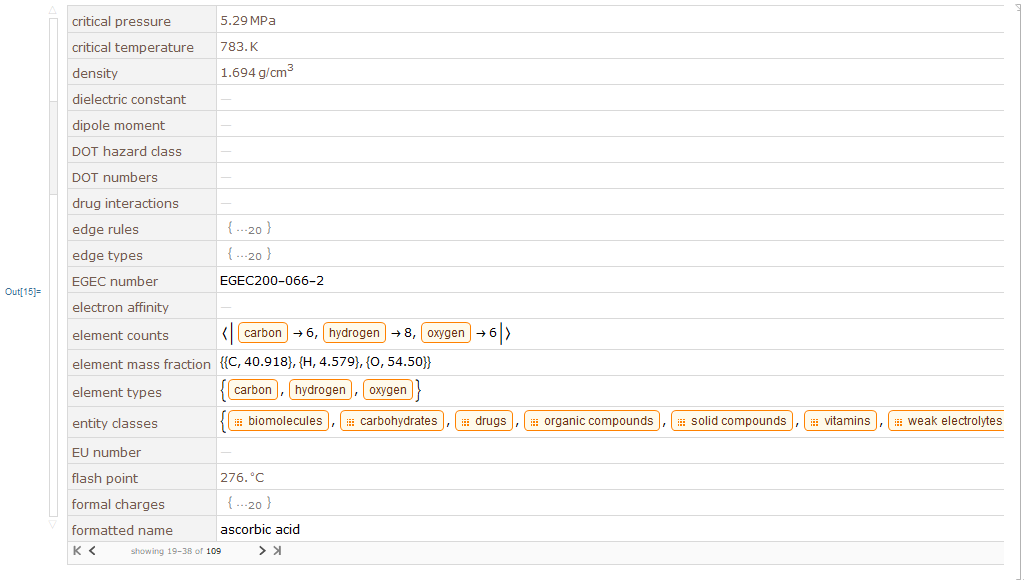
Another function option is Food, where the relative amount of each vitamin in a specific food is determined:
VitaminData["C", "Food" -> "Banana"]

If we use the function only with Food, without naming the vitamin, the full list of vitamins for a specific food is shown:
VitaminData["Food" -> "Apple"]

Another option for the function is Nutri, which is the nutritional information of foods in label form. Below is the example for four types of foods:
Table[VitaminData[
"Nutri" -> n], {n, {"Banana", "Carrot", "Shrimp", "Salmon"}}]
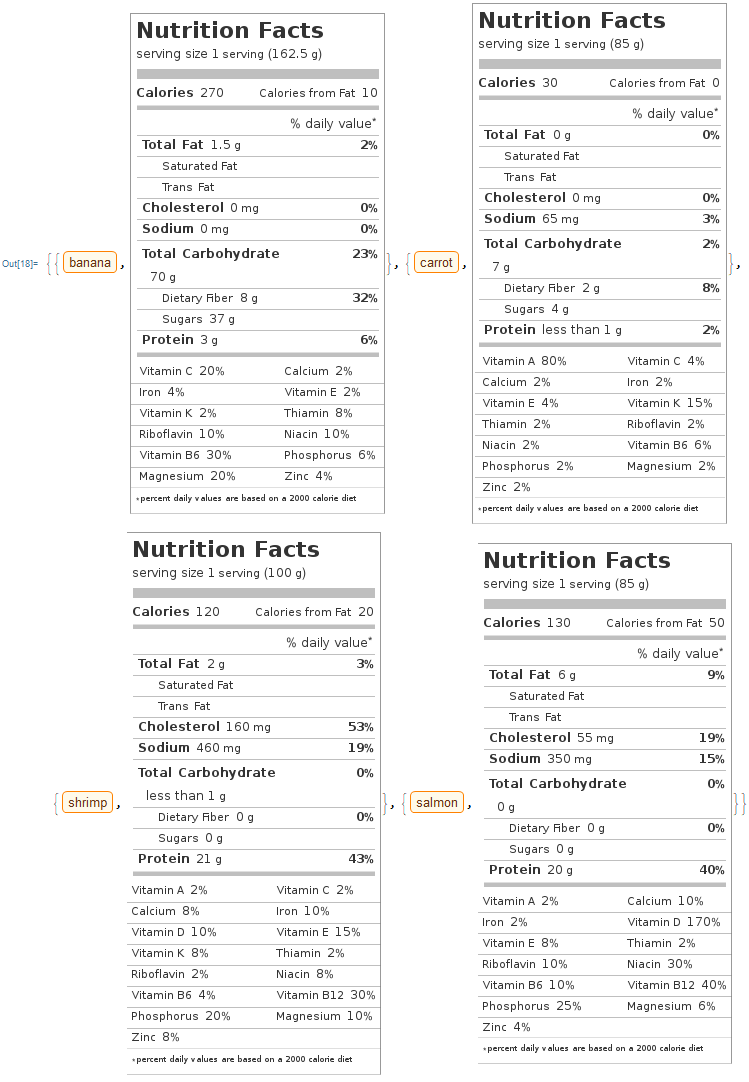
Code
Code of the function VitaminData[]: VitaminData["List"] := VitaminData["A", "Show" -> "List"];
VitaminData[vita_, OptionsPattern[]] :=
Module[{Vitamin, vitamins, ss, cc, a0, a1, a2, a3, a4, a5, a6, a7,
ai}, Options[VitaminData] = {"Show" -> "Entity"};
ss = {"A", "B1", "B2", "B3", "B4", "B5", "B6", "B12", "C", "D2",
"D3", "H", "H1", "K1", "K3", "K5", "M", "P", "AlphaTocopherol",
"DAlphaTocopherol", "Niacin", "Choline"};
Vitamin[vit_] := (vitamins =
Join[Table[
Entity["Chemical",
StringJoin["Vitamin", i]], {i, {"A", "B1", "B2", "B3", "B4",
"B5", "B6", "B12", "C", "D2", "D3", "H", "H1", "K1", "K3",
"K5", "M", "P"}}],
Table[Entity["Chemical",
j], {j, {"AlphaTocopherol", "DAlphaTocopherol", "Niacin",
"Choline"}}]]; cc = vit /. AssociationThread[ss, Range@22];
vitamins[[cc]]); a0 = Thread[{ss, Vitamin[All]}];
a1 = Vitamin[vita];
a2 = Dataset[
EntityValue[Vitamin[vita],
EntityValue[Vitamin[vita], "Properties"],
"PropertyAssociation"]];
a3 = MoleculePlot[Vitamin[vita], ImageSize -> Large];
a4 = MoleculePlot3D[Vitamin[vita], ImageSize -> Large];
a5 = BondList@Vitamin[vita]; a6 = Counts@AtomList@Vitamin[vita];
a7 = Thread[{Map[Text[Style[#, Small]] &,
DeleteCases[
StringReplace[
StringDelete[
EntityValue[Entity["Chemical", "VitaminA"], "Properties"] //
InputForm // ToString, {"EntityProperty[", "Chemical",
"]"}], {FromCharacterCode[32] -> ""}] // ToExpression,
""]], EntityValue[Entity["Chemical", "VitaminA"],
"Properties"]}];
ai = EntityValue[Vitamin[vita], OptionValue["Show"]];
If[MemberQ[{"List", "Entity", "Data", "Model2D", "Model3D", "Bonds",
"Atoms", "Mass", "Properties"}, OptionValue["Show"]] == True,
OptionValue["Show"] /. {"List" -> a0, "Entity" -> a1, "Data" -> a2,
"Model2D" -> a3, "Model3D" -> a4, "Bonds" -> a5, "Atoms" -> a6,
"Properties" -> a7}, ai]]
VitaminData["Nutri" -> al_] := {Entity["FoodType", al],
Entity[
"Food", {EntityProperty["Food", "FoodType"] ->
ContainsExactly[{Entity["FoodType", al]}],
EntityProperty["Food", "AddedFoodTypes"] ->
ContainsExactly[{}]}][
EntityProperty["Food", "NutritionLabel"]]};
VitaminData[x_, "Food" -> y_] :=
Module[{bb},
bb = Entity[
"Food", {EntityProperty["Food", "FoodType"] ->
ContainsExactly[{Entity["FoodType", y]}],
EntityProperty["Food", "AddedFoodTypes"] ->
ContainsExactly[{}]}][
EntityProperty["Food",
x /. AssociationThread[{"A", "B1", "B2", "B3", "B4", "B5", "B6",
"B12", "C", "D2", "D3", "H", "H1", "K1", "K3", "K5", "M", "P",
"AlphaTocopherol", "DAlphaTocopherol", "Niacin",
"Choline"}, {"RelativeVitaminAContent",
"RelativeThiaminContent", "RelativeRiboflavinContent",
"NoData", "NoData", "RelativePantothenicAcidContent",
"RelativeVitaminB6Content", "RelativeVitaminB12Content",
"RelativeVitaminCContent", "RelativeVitaminD2Content",
"RelativeVitaminD3Content", "RelativeBiotinContent", "NoData",
"RelativeVitaminKContent", "RelativeVitaminKContent",
"RelativeVitaminKContent", "RelativeFolicAcidContent",
"NoData", "RelativeVitaminEContent",
"RelativeVitaminEContent", "RelativeNiacinContent",
"RelativeCholineContent"}]]];
If[QuantityQ[bb] == True, {x, bb}, {x, "NoData"}]];
VitaminData["Food" -> an_] :=
Map[VitaminData[#, "Food" -> an] &, {"A", "B1", "B2", "B3", "B4",
"B5", "B6", "B12", "C", "D2", "D3", "H", "H1", "K1", "K3", "K5",
"M", "P", "AlphaTocopherol", "DAlphaTocopherol", "Niacin",
"Choline"}]
Food Ranking
Below we can see that there are 1816 foods in the Mathematica database as FoodType entities. I decided to leave this option out of the VitaminData[] function because each evaluation takes a long time to perform.
SparseArray@EntityList@Entity["FoodType"]

Below are some examples of vitamin ranking lists (top 10 foods) for all foods in the database. In this case I could specify some very specific types as well, such as Beta-Tocopherol (instead of Alpha-Tocopherol, for example) and vitamin D3:
Vitamin C MaximalBy[
Thread[{EntityList@Entity["FoodType"],
Map[Entity[
"Food", {EntityProperty["Food", "FoodType"] ->
ContainsExactly[{#}],
EntityProperty["Food", "AddedFoodTypes"] ->
ContainsExactly[{}]}][
EntityProperty["Food", "RelativeVitaminCContent"]] &,
EntityList@Entity["FoodType"]]}], Last, UpTo[10]]

Vitamin A MaximalBy[
Thread[{EntityList@Entity["FoodType"],
Map[Entity[
"Food", {EntityProperty["Food", "FoodType"] ->
ContainsExactly[{#}],
EntityProperty["Food", "AddedFoodTypes"] ->
ContainsExactly[{}]}][
EntityProperty["Food", "RelativeVitaminAContent"]] &,
EntityList@Entity["FoodType"]]}], Last, UpTo[10]]

Vitamin B6 MaximalBy[
Thread[{EntityList@Entity["FoodType"],
Map[Entity[
"Food", {EntityProperty["Food", "FoodType"] ->
ContainsExactly[{#}],
EntityProperty["Food", "AddedFoodTypes"] ->
ContainsExactly[{}]}][
EntityProperty["Food", "RelativeVitaminB6Content"]] &,
EntityList@Entity["FoodType"]]}], Last, UpTo[10]]

Beta-Tocopherol MaximalBy[
Thread[{EntityList@Entity["FoodType"],
Map[Entity[
"Food", {EntityProperty["Food", "FoodType"] ->
ContainsExactly[{#}],
EntityProperty["Food", "AddedFoodTypes"] ->
ContainsExactly[{}]}][
EntityProperty["Food", "RelativeBetaTocopherolContent"]] &,
EntityList@Entity["FoodType"]]}], Last, UpTo[10]]

Vitamin D3 MaximalBy[
Thread[{EntityList@Entity["FoodType"],
Map[Entity[
"Food", {EntityProperty["Food", "FoodType"] ->
ContainsExactly[{#}],
EntityProperty["Food", "AddedFoodTypes"] ->
ContainsExactly[{}]}][
EntityProperty["Food", "RelativeVitaminD3Content"]] &,
EntityList@Entity["FoodType"]]}], Last, UpTo[10]]

These lists above were just a few examples of vitamin ranking using all foods in the database and could be extended to various other substances.
Thanks.
|